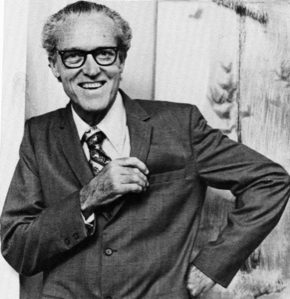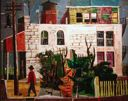William Lewis Lester
Dallas Nine
American, (1910–1991)
William Lewis Lester, painter and art teacher, son of John Lewis and Mildred Matilda (Padgett) Lester, was born in Graham, Texas, on August 20, 1910. He had nine sisters. He moved to Dallas with his family in 1924 and graduated from Woodrow Wilson High School there in 1929. He then studied at the Dallas Art Institute with Thomas M. Stell, Jr., and Olin H. Travis, while associating with other young artists, including Alexandre Hogue, Jerry Bywaters, Otis M. Dozier, Everett Spruce, and Perry Nichols, among others. (see DALLAS NINE.) He was an active member of the Dallas Artists League beginning with its formation in 1932. During the Great Depression era, the members formed a nucleus of artists who led in the development of a Texas Regionalist style. At the time, Dallas was one of the strongest and most dynamic centers of the regional art movement in the country. In 1938 many of the Dallas artists, including Lester, formed the Lone Star Printmakers. For the next four years they created and exhibited their lithographic prints. The impetus for this activity for these young, financially poor artists was the chance to explore a new medium and to display their work without incurring the higher costs associated with crating, shipping, and insuring paintings and sculpture. Also in 1938 Lester married Sylvia Louise Bachrach of Dallas; they were married for fifty-three years and had two children.
Lester spent two summers in the early 1930s painting at Olin Travis's cabin in rural Arkansas. He served as a staff artist with the Civilian Conservation Corps at Palo Duro Canyon and Fort Sill, Oklahoma, in 1934–35. During the latter part of the 1930s, he earned his livelihood as a draftsman with Texas Power and Light in Dallas while he continued to paint. From 1940 to 1942 he taught at the school of the Dallas Museum of Fine Arts (later the Dallas Museum of Art). Lester joined the faculty of the College of Fine Arts at the University of Texas at Austin in 1942 and taught there until his retirement as professor emeritus in 1972. He served as chairman of the art department from 1952 to 1954. During the summers of 1949 and 1950, he was guest professor at Sul Ross College in Alpine, Texas. William Lester died November 27, 1991, in Austin.
The Dallas movement in which Lester played a central role reflected the distinct influence of the local environment. The artists' paintings characteristically projected an intensely subjective approach to the landscapes and other subject matter around them within an American Scene and surrealist aesthetic. Their work revealed an interest in ideas and in distinct forms rather than in illustration. They rejected imitations of established artistic styles, such as impressionistic treatments of nature, and renditions of conventional local subjects, such as bluebonnet fields. For a time, Lester's subject matter remained allied with the American Scene movement, but his treatment became looser and more abstract. His paintings of natural scenes, buildings, and people became very personalized and gestural. Color became more vibrant and central to his work, as did his emphasis on strong composition. His admiration of certain Mexican artworks, particularly the striking combinations of brilliant color by Rufino Tamayo, influenced his own use of color from the mid-1950s onward. By the mid-1960s many of his paintings tended toward complete abstraction.
Lester exhibited widely and achieved considerable recognition during his career. He first gained national attention as one of the exhibitors at the Texas Centennial Exposition in Dallas in 1936. In that same year, his work was shown at the First National Exhibition of American Art at the Rockefeller Center in New York. His paintings were also shown at other expositions and museums around the country, including the Pan American Exposition in Dallas (1937), the Golden Gate Exposition, and the New York World's Fair Exhibition (1939). It was also shown at the Philadelphia Academy of Fine Arts (1940), the Brooklyn Museum (1941), the Fine Arts Society of San Diego (1941), the Art Institute of Chicago (1942), the Denver Art Museum (1944), the Exhibition of Contemporary American Painting, San Francisco (1952), the Colorado Springs Fine Arts Center (1955), and the Pan American Union, Washington, D.C. (1968). In addition, his work was shown repeatedly at major art museums in Texas. Some of his major solo exhibitions were at the Passadoit Gallery in New York (1948, 1950, 1953); the Dayton (Ohio) Art Institute (1949); Palacio de Bellas Artes in Mexico City (1970); and at numerous museums and galleries throughout Texas. His work is represented in the permanent collections of many leading art museums and other collections, including the Metropolitan Museum of Art, New York; the Whitney Museum, New York; the American Academy of Arts and Letters; the Pennsylvania Academy of Fine Arts; the Dallas Museum of Art; the Museum of Fine Arts, Houston; the Witte Museum, San Antonio; the Huntington Art Museum of the University of Texas at Austin; the Modern Art Museum of Fort Worth; and the American Embassy in Paris.
Source: Texas State Historical Association
Dallas Nine
American, (1910–1991)
William Lewis Lester, painter and art teacher, son of John Lewis and Mildred Matilda (Padgett) Lester, was born in Graham, Texas, on August 20, 1910. He had nine sisters. He moved to Dallas with his family in 1924 and graduated from Woodrow Wilson High School there in 1929. He then studied at the Dallas Art Institute with Thomas M. Stell, Jr., and Olin H. Travis, while associating with other young artists, including Alexandre Hogue, Jerry Bywaters, Otis M. Dozier, Everett Spruce, and Perry Nichols, among others. (see DALLAS NINE.) He was an active member of the Dallas Artists League beginning with its formation in 1932. During the Great Depression era, the members formed a nucleus of artists who led in the development of a Texas Regionalist style. At the time, Dallas was one of the strongest and most dynamic centers of the regional art movement in the country. In 1938 many of the Dallas artists, including Lester, formed the Lone Star Printmakers. For the next four years they created and exhibited their lithographic prints. The impetus for this activity for these young, financially poor artists was the chance to explore a new medium and to display their work without incurring the higher costs associated with crating, shipping, and insuring paintings and sculpture. Also in 1938 Lester married Sylvia Louise Bachrach of Dallas; they were married for fifty-three years and had two children.
Lester spent two summers in the early 1930s painting at Olin Travis's cabin in rural Arkansas. He served as a staff artist with the Civilian Conservation Corps at Palo Duro Canyon and Fort Sill, Oklahoma, in 1934–35. During the latter part of the 1930s, he earned his livelihood as a draftsman with Texas Power and Light in Dallas while he continued to paint. From 1940 to 1942 he taught at the school of the Dallas Museum of Fine Arts (later the Dallas Museum of Art). Lester joined the faculty of the College of Fine Arts at the University of Texas at Austin in 1942 and taught there until his retirement as professor emeritus in 1972. He served as chairman of the art department from 1952 to 1954. During the summers of 1949 and 1950, he was guest professor at Sul Ross College in Alpine, Texas. William Lester died November 27, 1991, in Austin.
The Dallas movement in which Lester played a central role reflected the distinct influence of the local environment. The artists' paintings characteristically projected an intensely subjective approach to the landscapes and other subject matter around them within an American Scene and surrealist aesthetic. Their work revealed an interest in ideas and in distinct forms rather than in illustration. They rejected imitations of established artistic styles, such as impressionistic treatments of nature, and renditions of conventional local subjects, such as bluebonnet fields. For a time, Lester's subject matter remained allied with the American Scene movement, but his treatment became looser and more abstract. His paintings of natural scenes, buildings, and people became very personalized and gestural. Color became more vibrant and central to his work, as did his emphasis on strong composition. His admiration of certain Mexican artworks, particularly the striking combinations of brilliant color by Rufino Tamayo, influenced his own use of color from the mid-1950s onward. By the mid-1960s many of his paintings tended toward complete abstraction.
Lester exhibited widely and achieved considerable recognition during his career. He first gained national attention as one of the exhibitors at the Texas Centennial Exposition in Dallas in 1936. In that same year, his work was shown at the First National Exhibition of American Art at the Rockefeller Center in New York. His paintings were also shown at other expositions and museums around the country, including the Pan American Exposition in Dallas (1937), the Golden Gate Exposition, and the New York World's Fair Exhibition (1939). It was also shown at the Philadelphia Academy of Fine Arts (1940), the Brooklyn Museum (1941), the Fine Arts Society of San Diego (1941), the Art Institute of Chicago (1942), the Denver Art Museum (1944), the Exhibition of Contemporary American Painting, San Francisco (1952), the Colorado Springs Fine Arts Center (1955), and the Pan American Union, Washington, D.C. (1968). In addition, his work was shown repeatedly at major art museums in Texas. Some of his major solo exhibitions were at the Passadoit Gallery in New York (1948, 1950, 1953); the Dayton (Ohio) Art Institute (1949); Palacio de Bellas Artes in Mexico City (1970); and at numerous museums and galleries throughout Texas. His work is represented in the permanent collections of many leading art museums and other collections, including the Metropolitan Museum of Art, New York; the Whitney Museum, New York; the American Academy of Arts and Letters; the Pennsylvania Academy of Fine Arts; the Dallas Museum of Art; the Museum of Fine Arts, Houston; the Witte Museum, San Antonio; the Huntington Art Museum of the University of Texas at Austin; the Modern Art Museum of Fort Worth; and the American Embassy in Paris.
Source: Texas State Historical Association
Artist Objects
Old White Store 1983.033


